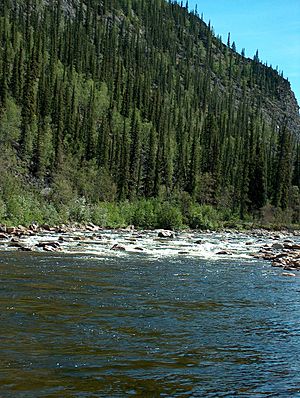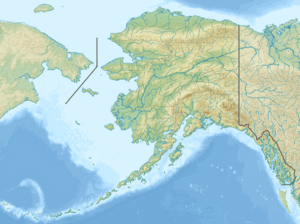Charley River facts for kids
Quick facts for kids Charley River |
|
|---|---|

Flowing through Yukon–Charley Rivers National Preserve
|
|
|
Location of the mouth of the Charley River in Alaska
|
|
| Country | United States |
| State | Alaska |
| Census Area | Southeast Fairbanks, Yukon–Koyukuk |
| Physical characteristics | |
| Main source | Mertie Mountains Yukon–Charley Rivers National Preserve, Southeast Fairbanks Census Area 4,023 ft (1,226 m) 64°42′15″N 144°02′41″W / 64.70417°N 144.04472°W |
| River mouth | Yukon River 55 miles (89 km) northwest of Eagle, Yukon–Koyukuk Census Area 686 ft (209 m) 65°19′02″N 142°46′50″W / 65.31722°N 142.78056°W |
| Length | 88 mi (142 km) |
| Type: | Wild |
| Designated: | December 2, 1980 |
The Charley River is a beautiful river located in Alaska, United States. It flows for about 88 miles (142 km). This river is a "tributary" of the much larger Yukon River. A tributary is a smaller river that flows into a bigger one. The Charley River starts in the Mertie Mountains. It flows through a special protected area called the Yukon–Charley Rivers National Preserve. This preserve helps keep the river and its surroundings wild and natural.
Contents
About the Charley River
The Charley River begins high up in the Mertie Mountains. These mountains are in the northeastern part of Alaska. The river then flows generally towards the northeast. Its entire path is within the Yukon–Charley Rivers National Preserve. This means the river and its natural environment are protected.
The Charley River eventually joins the Yukon River. This meeting point is about 55 miles (89 km) southwest of a town called Eagle. The river also forms part of the border between two areas in Alaska. These are the Southeast Fairbanks and Yukon–Koyukuk census areas.
Wild and Scenic River Status
In 1980, the Charley River became part of the National Wild and Scenic Rivers System. This is a special program in the United States. It protects certain rivers that have outstanding natural, cultural, or recreational value.
Being a "wild" river means it is kept free-flowing and undeveloped. About 208 miles (335 km) of the Charley River and its main smaller streams were given this special protection. These streams include Copper, Bonanza, Hosford, Derwent, Flat-Orthmer, Crescent, and Moraine creeks.
River Environment and Trees
The area around the Charley River is mostly covered by forests. The main types of trees you'll find here are black spruce and white spruce. Black spruce trees are especially interesting. The Charley River area is about as far west as these trees grow in the Yukon River region.
Boating on the Charley River
Many people enjoy floating down the Charley River. They often use rafts, inflatable canoes, or kayaks. It's a great way to see the beautiful Alaskan wilderness.
River Difficulty Ratings
Rivers are often rated by how difficult they are to navigate. This helps people know what to expect. The upper part of the Charley River is rated Class III. This means it has intermediate rapids. It can become Class IV (advanced) when the water levels are high.
The lower 76 miles (122 km) of the river are usually easier. They are rated Class II (novice) to Class III. This means they are suitable for beginners or those with some experience.
Things to Watch Out For
Even on easier sections, rivers can have dangers. On the Charley River, you might encounter:
- Swift currents: The water moves quickly.
- Overhanging or submerged vegetation: Trees or plants can be in or over the water.
- Rocks: Hidden or visible rocks can be obstacles.
- Rapids: Sections of rough, fast-moving water.
- Weather-related water level changes: The water level can go up or down quickly depending on the weather.
It's always important to be careful and prepared when boating on any river.


